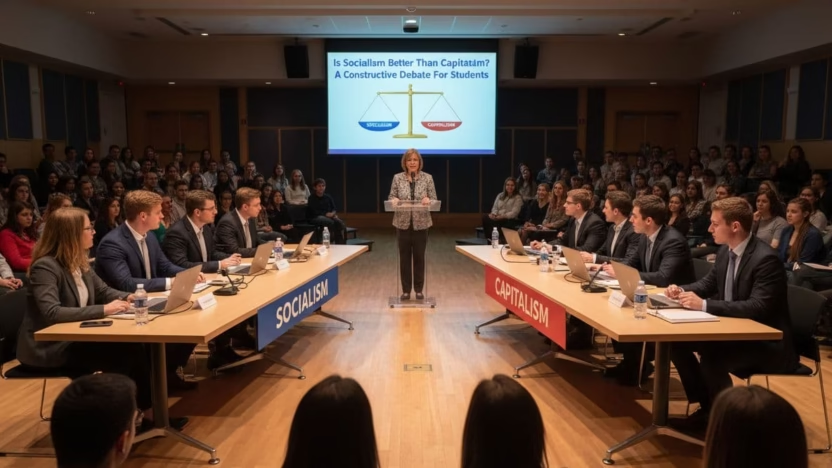Imagine two classmates sitting the same exam.
One goes home to a quiet house, fast laptop, and a private tutor. The other shares a noisy room with siblings, works late shifts, and worries about rent. Same exam, very different starting points.
Behind scenes like this sit big ideas about how money, work, and public services should run. Socialism and capitalism are two of the most important of those ideas. They shape tuition fees, student debt, job chances, housing costs, and even climate policy.
This is not about picking a winner or telling you what to think. Instead, the goal is to understand both sides so you can build your own view, argue it well, and update it as you learn more.
In 2025, with rising living costs, record student debt in the UK, and worries about AI and climate change, these systems are not just history topics. They are part of your daily life and your future.
Key Takeaways: What You Will Learn From This Debate
- Simple definitions of socialism and capitalism, with clear, student-friendly examples.
- Main pros and cons of each system, including how they affect inequality, jobs, and services like healthcare and education.
- How these systems shape student life, from tuition fees and student loans to graduate jobs and mental health.
- Why most countries mix ideas from both, rather than using pure socialism or pure capitalism.
- How to think about your own values, like freedom, fairness, opportunity, and security, when judging each system.
Table of Contents
- Key Takeaways: What You Will Learn From This Debate
- What Is Capitalism? The System of Markets, Profit, and Choice
- What Is Socialism? Sharing Resources for Fairness and Security
- Socialism vs Capitalism: Which System Works Better for Students’ Futures?
- Frequently Asked Questions About the Socialism vs Capitalism Debate
- Conclusion
What Is Capitalism? The System of Markets, Profit, and Choice
Capitalism is an economic system where most businesses are owned by individuals or private companies. These businesses compete to make profit by selling goods or services that people want.
A few key ideas sit at the centre of capitalism:
- Private property: People and companies can own land, factories, shops, apps, and so on.
- Markets: Buyers and sellers meet in markets, both physical and online, to decide prices.
- Supply and demand: When lots of people want something and there is not much of it, prices rise. When demand falls or supply grows, prices usually drop.
- Profit motive: Companies try to earn more than they spend. Profit is a main reason they take risks and invest.
Think of popular food delivery apps or streaming services. Different companies compete for your attention. They try to make their product cheaper, faster, or more enjoyable than others, so you sign up with them. If they get it right, they make money. If they fail, they might shut down.
For students, capitalism appears in many places:
- Your part-time job, where your employer pays you a wage to help them make profit.
- Your choices as a consumer, from budget foods to premium brands.
- Your future career plans, where you might choose high-salary paths such as the high-salary degree options many students research.
Capitalism can feel like a huge marketplace, full of chances and choices, but also full of pressure and risk.
Advantages of Capitalism: Innovation, Variety, and Personal Rewards
Supporters of capitalism like its link with innovation. When companies compete, they race to create new tech, faster services, and cooler products. This is how new apps, medical devices, and green technologies often appear.
Capitalism also offers variety. You can pick from many phones, courses, or food brands, depending on your budget and taste. If you spot a gap in the market, you could start your own small business or online shop.
There is also a strong idea of personal reward. If you work hard, build skills, or come up with a clever idea, you may earn more money. For example, a student project might grow into a start-up, or learning in-demand skills could lead to a high-paying job.
Competition can push companies to lower prices or improve quality, which can be good for consumers and sometimes for workers too.
Problems of Capitalism: Inequality, Risk, and Pressure on Workers
The biggest criticism of capitalism is inequality. It can create large gaps between rich and poor. Some people inherit wealth or gain huge profits, while others struggle on low pay and insecure work.
For students, this can show up in:
- Worry about paying for university, especially with tuition fees up to £9,250 per year in England and rising living costs.
- Student debt, with average borrowing close to £45,000 and total UK student loan debt already above £290 billion.
- Unpaid internships or low-paid placements that only some students can afford to take.
The job market can be unstable. Zero-hours contracts and gig work leave many young people unsure how much they will earn each month. There is also constant pressure to improve, work longer hours, and be available at all times.
People who are ill, disabled, or face discrimination can get left behind. Housing costs can rise faster than wages. In a strongly capitalist system, life can feel like a race where some start far ahead of others.
What Is Socialism? Sharing Resources for Fairness and Security
Socialism is an economic and political idea that focuses on sharing wealth and resources more fairly. Instead of leaving most decisions to private companies and markets, socialism gives a bigger role to the state or to communities.
A few core ideas:
- Public ownership of key services: Things like healthcare, main transport systems, or energy companies may be owned by the state or run for public benefit, not profit.
- Strong social safety nets: The state provides benefits, free or low-cost healthcare, and support if you lose your job or cannot work.
- Focus on equality and fairness: Policies aim to reduce the gap between rich and poor.
The UK already has some socialist features, like the NHS, which offers healthcare free at the point of use. Many European countries mix strong social policies with market economies. In some Nordic nations, for example, higher taxes help pay for lower university fees, better parental leave, and stronger social support.
There is no single version of socialism. At one end, you have mild forms in social democracies that mix markets with high levels of welfare. At the other end, you have systems where the state controls most of the economy and private business is heavily restricted.
For students, socialism can mean lower fees, better grants, and less fear of falling into poverty if something goes wrong. But it also raises questions about how much control the government should have and how high taxes should be.
Benefits of Socialism: Equality, Safety Nets, and Community Support
Supporters of socialism argue that it reduces poverty and insecurity. By taxing higher earners more and using that money for public services, societies can give everyone a safer starting point.
For students, this can mean:
- Free or low-cost university fees, which reduce or remove student debt.
- Grants, bursaries, and housing support, so you can study without constant money stress.
- Guaranteed healthcare, which means you can see a doctor, get counselling, or receive treatment without huge bills.
When people feel protected by a safety net, they can focus more on learning and long-term goals. There is also a strong idea of solidarity: society works together like a team, sharing resources so that no one is abandoned.
Problems of Socialism: Efficiency, Motivation, and Government Power
Critics worry that socialism can lead to slow or inefficient services. If a public service has no competition, staff may have less reason to improve speed or quality. Waiting lists can grow and innovation may slow down.
Another concern is motivation. If rewards are quite similar whether you work very hard or just enough, some people might do the minimum. This raises the question: will people still push for big new ideas if they cannot keep much of the extra reward?
There is also the issue of government power. Strong socialist systems often give the state more control over the economy and people’s lives. If that power is not checked, it can lead to corruption, limits on free speech, or poor decision making that affects millions.
History shows examples of both success and failure. Some countries with strong social policies have high living standards and competitive economies. Others, with very centralised control, have suffered shortages, lack of freedom, and weak growth.
Socialism vs Capitalism: Which System Works Better for Students’ Futures?
When you compare socialism and capitalism, you are really comparing values and trade-offs. Both systems try to answer questions like:
- Who should own key industries?
- How should wealth be shared?
- How much freedom should markets have?
- What support should people get if they struggle?
For students, the key areas are fairness, opportunity, job prospects, and long-term issues like climate change and AI.
In a more capitalist model, you may face higher tuition fees and more personal risk, but also more choice and potential for high pay. In a more socialist model, you may get stronger public support and less debt, but also higher taxes and more rules on business.
Most real countries sit somewhere in the middle. The UK, for example, has a market-based economy with private companies, but also public healthcare and student loans run by the state. This mixed position is common in modern societies.
When you think about which system is “better”, it often comes down to what you care about most: freedom, fairness, security, or opportunity. Constructive debate means trying to understand all of these, not just the ones you already agree with. If you want to sharpen those skills, it can help to study tools like stronger argument techniques.
Fairness and Opportunity: Who Gets a Real Chance to Succeed?
Capitalism often creates big rewards for a small group, such as top entrepreneurs or investors. Scholarships and student loans can help others, but many students still graduate with heavy debt that shapes their choices for decades.
Socialism tries to give more people a similar starting point. Free-tuition models or very low fees, plus grants for living costs, aim to make university access less dependent on family income. This can reduce stress and widen opportunity.
In practice, many countries use a mix: loans, grants, and sometimes free tuition. These systems raise questions about who pays now, who pays later, and how to balance support with personal responsibility.
Innovation, Jobs, and the Environment: Planning for the Future
New technology and green energy will shape the careers you enter. A more capitalist system can produce rapid innovation, since companies race to build the next big app, medical tool, or climate tech solution. This opens up many job paths in data, AI, biotech, and more.
A more socialist system is likely to place stronger rules on pollution, worker rights, and safety. Governments may invest heavily in public transport, renewable energy, and green jobs.
For students thinking about work in tech, healthcare, or climate fields, both systems matter. You might see fast growth in private companies, alongside public projects that focus on long-term environmental goals.
Whichever system dominates, you still need strong personal skills and planning. Resources on effective exam study strategies can help you build the academic foundation that both economies reward.
Frequently Asked Questions About the Socialism vs Capitalism Debate
Q1: Can a country use both socialism and capitalism at the same time?
Yes. Most modern countries are mixed economies. They have markets and private companies, but also public services like schools, hospitals, and welfare.
Q2: Do any real countries follow pure socialism or pure capitalism?
No. Pure forms are mostly theories. Real countries usually mix ideas, changing the balance over time with elections and reforms.
Q3: How do these systems affect student debt and tuition fees?
More capitalist systems tend to have higher tuition fees and more student loans. Systems with stronger socialist policies are more likely to offer low or no tuition, higher grants, and less personal debt.
Q4: Which system supports mental health and work life balance better?
Countries with strong social policies often invest more in healthcare, counselling, and work protections. However, supportive families, good uni services, and personal habits also play a big part in mental health.
Q5: What can young people do if they want fairer systems?
You can learn about policy, vote, join student groups, take part in debates, and support charities or campaigns. Small actions, repeated across a generation, can shift how your country balances socialism and capitalism.
Q6: Will AI and automation change the socialism vs capitalism debate?
Yes. As machines do more work, societies must decide how to share the gains. This may push discussions about basic income, job guarantees, and stronger public support.
Conclusion
Socialism and capitalism are not just abstract theories. They shape your daily student life: rent, tuition, part-time work, and your plans after graduation.
Neither system is perfect. Capitalism can drive innovation and reward effort, but it often brings inequality and pressure. Socialism can reduce poverty and protect people, but it can also create inefficiencies and place a lot of power in government hands.
Most countries try to mix both, adjusting the balance in response to crises like student debt, climate change, or housing shortages. As a student in 2025, you have a stake in how that balance is set.
Keep reading, asking questions, and debating these ideas with friends, family, and teachers. Which mix of freedom, fairness, and security would you choose for your future society, and why?




